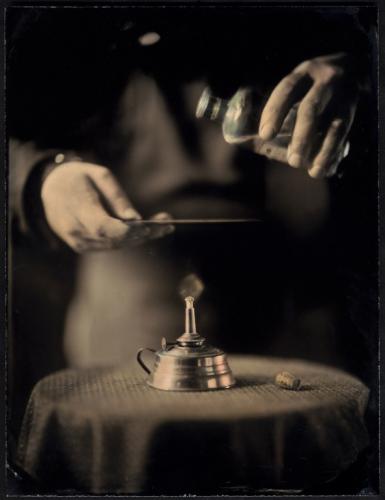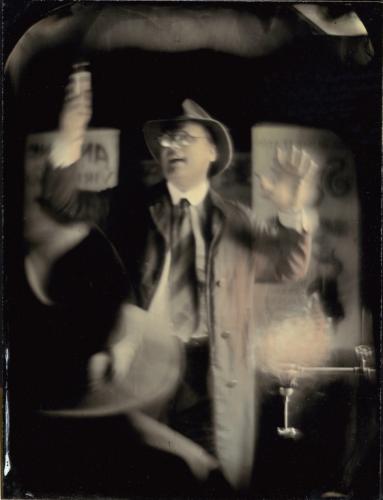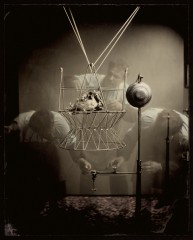Innovation is often associated with the idea of a new technology with challenging revolutionary responsibilities. The incredible mutation in the last ten years in the scenario regarding communication tools has without a doubt offered a vast choice of revolutionary, seasonal fetishes. Revolutionary however could primarily be the way in which we rethink of reality. These global digitalization years have largely established a break with the past, in this sense.
 Let's think of the new ways of producing photographs and movies. In order to appreciate whether, and by how much, it really is a revolution we need to simply take a trip back in time. The birth of photography in the nineteenth century marks, historically, the crucial transition towards a society that is bound to the use of images. Initially still images and eventually moving images. Daguerre and Niépce's early works are still the symbol of a change to be looked back upon in order to understand how the following century has grown in that direction. And that innovation is now going through a new transformation. We don't know how definitive it may be but it is surely just as 'historical': the digital synthesis with machines that are increasingly versatile - Instagram and other popular applications for cameras and smart-phones for example - are a replica of many of the photographic techniques and effects achieved so far. But reproduce doesn't mean, automatically, recuperate and preserve. The pioneering efforts of the first photo artisans, the first to familiarize themselves with the chemical properties of silver and the collodion techniques, risks ending up being mere archeology. The rapid digital transformation may be hiding the threat of deleting the memory and knowledge of the delicate balance between light and chemical reagents. The so-called digital natives have probably never even developed, or touched, a negative.
Let's think of the new ways of producing photographs and movies. In order to appreciate whether, and by how much, it really is a revolution we need to simply take a trip back in time. The birth of photography in the nineteenth century marks, historically, the crucial transition towards a society that is bound to the use of images. Initially still images and eventually moving images. Daguerre and Niépce's early works are still the symbol of a change to be looked back upon in order to understand how the following century has grown in that direction. And that innovation is now going through a new transformation. We don't know how definitive it may be but it is surely just as 'historical': the digital synthesis with machines that are increasingly versatile - Instagram and other popular applications for cameras and smart-phones for example - are a replica of many of the photographic techniques and effects achieved so far. But reproduce doesn't mean, automatically, recuperate and preserve. The pioneering efforts of the first photo artisans, the first to familiarize themselves with the chemical properties of silver and the collodion techniques, risks ending up being mere archeology. The rapid digital transformation may be hiding the threat of deleting the memory and knowledge of the delicate balance between light and chemical reagents. The so-called digital natives have probably never even developed, or touched, a negative.
 As is known, this change has had an affect on other items as well - newspapers, record albums and books in bookstores could become a thing of the past - and it has been the subject of debates, not without rhetoric: adapt or hold out for as long as possible? Is it the end of creating culture as it has been created so far? Can we go back to the 'horse and carriage'? The closure of Kodak - the multinational company known for its Kodachrome film - last January is quite indicative. Despite its long history and famous brand name, which may have enabled it to meet this challenge, it had to accept the death of camera film. Nevertheless, the (undeclared) promise of revolutionizing the way we create art with new means linked to images deserves to be tackled, overcoming the inevitable rhetoric, so as to establish the importance of the innovation of instagram and the like in order to understand just how much we can do without tradition. Artist & Alchemists is the title of a documentary produced by Market Street Productions - at the moment in post production – which tells the origins of photography, the evolution of the chemical processes involved, how technology has grown and its impact on the modern world. Which essentially means telling the story of innovation without precedent in History.
As is known, this change has had an affect on other items as well - newspapers, record albums and books in bookstores could become a thing of the past - and it has been the subject of debates, not without rhetoric: adapt or hold out for as long as possible? Is it the end of creating culture as it has been created so far? Can we go back to the 'horse and carriage'? The closure of Kodak - the multinational company known for its Kodachrome film - last January is quite indicative. Despite its long history and famous brand name, which may have enabled it to meet this challenge, it had to accept the death of camera film. Nevertheless, the (undeclared) promise of revolutionizing the way we create art with new means linked to images deserves to be tackled, overcoming the inevitable rhetoric, so as to establish the importance of the innovation of instagram and the like in order to understand just how much we can do without tradition. Artist & Alchemists is the title of a documentary produced by Market Street Productions - at the moment in post production – which tells the origins of photography, the evolution of the chemical processes involved, how technology has grown and its impact on the modern world. Which essentially means telling the story of innovation without precedent in History.
 But that's not all. In Artist & Alchemists the protagonists are artists whose work is to faithfully recreate the photographic techniques used in the 19th century in today's digital world. Actually France Scully and Mark Osterman had the idea of creating an artisan workshop way back in 1991. Reproducing the old collodion processes with the aid of versatile modern chemical substances is no mean feat. These two modern Daguerre collaborate with the George Eastman House International School of Photography and Film in Rochester, NY. They work with collodion processes and their photographs are created for private owners, galleries and exhibitions. They hold workshops, give lessons and write publications of various kinds. They are amongst the documentary's ten protagonists who were contacted by Chris Ekstein to give their views on this unique and passionate experience using new generation means of expression.
But that's not all. In Artist & Alchemists the protagonists are artists whose work is to faithfully recreate the photographic techniques used in the 19th century in today's digital world. Actually France Scully and Mark Osterman had the idea of creating an artisan workshop way back in 1991. Reproducing the old collodion processes with the aid of versatile modern chemical substances is no mean feat. These two modern Daguerre collaborate with the George Eastman House International School of Photography and Film in Rochester, NY. They work with collodion processes and their photographs are created for private owners, galleries and exhibitions. They hold workshops, give lessons and write publications of various kinds. They are amongst the documentary's ten protagonists who were contacted by Chris Ekstein to give their views on this unique and passionate experience using new generation means of expression.
France and Mark told me about their experience and their point of view on the relationship between technology and art.

What was your emotional reaction when doing Artists & Alchemists?
France Scully: “Naturally we were quite excited. We consider ourselves fortunate in being included in this group. But there's no diffidence as far as digital technology is concerned, I don't see ‘alternatives’ or 'anti-digital' historical photographic processes. It's not for this reason that what we use them. I use all the processes that can be applied to the type of work we want to do, including digital." Mark Osterman: “I worked full time for ten years as Historian of the Photographic Process at the George Eastman House here in Rochester, in New York. During this time I taught the evolution of photography from the pre-photographic techniques with gelatin emulsions to conservatories around the world. The rare 19th century photographic equipment we preserved was used for the sole purpose of understanding and teaching the the history of photography." "The producers of Artists&Alchemists asked me to concentrate on ambrotypes. I chose the traveling medicine ones, in order to present my work as a collection of memories. Concrete...but fragile at the same time."
France and Mark know the fine-line between technique and artistic expression quite well, how one should be complimentary to the other, even with regards to the old collodion processes.
 F: “We would like both the artists and the collectors to become more critical regarding the union between process and image. The process is not the artistic form, it is merely a support for the image – in the same way an artist chooses a particular color or brush. Those who nowadays use collodion seem to think that using a historical process means creating a great work of art” "When one reaches a certain familiarity with the technique there are numerous factors that contribute to creating an image. For example I like how the colors interact when using collodion and the longer exposure time. They add a dimension to my work. Each part of this experience is at the same time thought and vision. As an artist I find it very seductive. The Scully&Osterman was founded in 1991. In 20 years of activity is it possible to establish just how widespread the awareness of this tradition is?
F: “We would like both the artists and the collectors to become more critical regarding the union between process and image. The process is not the artistic form, it is merely a support for the image – in the same way an artist chooses a particular color or brush. Those who nowadays use collodion seem to think that using a historical process means creating a great work of art” "When one reaches a certain familiarity with the technique there are numerous factors that contribute to creating an image. For example I like how the colors interact when using collodion and the longer exposure time. They add a dimension to my work. Each part of this experience is at the same time thought and vision. As an artist I find it very seductive. The Scully&Osterman was founded in 1991. In 20 years of activity is it possible to establish just how widespread the awareness of this tradition is?

M: “Having to do with the collodion techniques revival we felt that the movement was still in an embryonic stage, at a level only for experts . There are many variations in technology that is based on collodion. But almost all artists that nowadays use this process, produce only direct positives, both ambrotypes and tintypes” “One of the obstacles that hindered the complete evolution of the revival is the process' defects when it isn't used carefully. The process artifacts- streaks and scratches - can be very appealing and, in some cases, can create a sensation which cannot be reproduced by other means. But on the other hand they can also be a simple distraction" "Then there are collodion negatives, a new, old, frontier that is still struggling to be used".
"Artists & Alchemists" is an important opportunity to reach a wider audience. Will it also give you the opportunity to increase your work exhibitions?
F: ”Yes, there are various programs for Europe. Anne Cartier-Bresson, for example, has already placed our work in an exhibit she organized, L'objet photographique: une invention permanente at the Maison Européenne de la Photographie, in Paris last year. More recently, in the autumn of 2011 our work was exhibited in the'“Eclats de photographie” at the Musée Adrien Mentienne of Bry-sur-Marne, in France. And we are planning to exhibit The Light at Lacock, Sun Sketches at the Twilight of Photography at the Talbot Museum of Lacock Abbey in England.
We are witnessing an era of radical changes. How much can we gain from tradition in order to look at the future?
M: "Perhaps tradition can tell us how these artifacts are still something to be revalued. And with time, as they become more and more rare, they can be even more precious, especially as a means of expression for artists."
[video:http://www.youtube.com/v/gI3WAEXJXDk]
Images Credits: ©Scully & Osterman
For info: Scully & Osterman - official website: http://www.collodion.org


